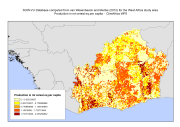urban population
Type of resources
Available actions
Topics
Keywords
Contact for the resource
Provided by
Years
Formats
Representation types
Update frequencies
status
Resolution
-
The FGGD high-resolution urban population density map is a global raster datalayer with a resolution of 30 arc-seconds. Each pixel classified as urban by the urban area boundaries map contains the number of persons per square kilometre. All remaining pixels contain no data. The method used by FAO to generate this datalayer is described in FAO, 2006, Mapping global urban and rural population distributions, by M. Salvatore, et. al.
-
The FGGD high-resolution urban population distribution map is a global raster datalayer with a resolution of 30 arc-seconds. Each pixel classified as urban by the urban area boundaries map contains a numeric count of persons in the land area represented by the pixel. All remaining pixels contain a negative value. The method used by FAO to generate this datalayer is described in FAO, 2006, Mapping global urban and rural population distributions, by M. Salvatore, et. al.
-

SOW-VU "Africa in maps" database updated from van Wesenbeeck and Merbis, 2012. These include population maps (total, urban, rural, refugees/IDPs), food aid distribution, and estimates of total production measured in mt cereal equivalents per capita. This data set have been used to complement the survey data and included in the 'Climate change predictions in Sub-Saharan Africa: impacts and adaptations (ClimAfrica)" project, Work Package 5 (WP5). WP5 deals with economic assessment of agriculture and water sector based on a Computable General Equilibrium analysis (ICES) to produce the "inaction" and the adaptation scenarios, for direct climate change impacts on agricultural activity and on the direct cost and effectiveness of adaptation strategies. The main advantage of this investigation approach is to depict the economy as a system where goods and factor markets interacts domestically and internationally. Price effects, competitiveness effects, and demand & supply adjustments triggered by impacts on the agricultural sector can thus be properly captured. Moreover, the spatially explicit and dynamic economic modeling of vulnerability will have to accommodate bio-physical vulnerabilities. More information on ClimAfrica project's scope and objectives is provided in the Supplemental Information section of this metadata.
-

SOW-VU "Africa in maps" database updated from van Wesenbeeck and Merbis, 2012. These include population maps (total, urban, rural, refugees/IDPs), food aid distribution, and estimates of total production measured in mt cereal equivalents per capita. This data set have been used to complement the survey data and included in the "Climate change predictions in Sub-Saharan Africa: impacts and adaptations (ClimAfrica)" project, Work Package 5 (WP5). More information on ClimAfrica project is provided in the Supplemental Information section of this metadata. The study in WP5 aimed to identify, locate and characterize groups that are vulnerable for climate change conditions in two country clusters; one in West Africa (Benin, Burkina Faso, Côte d'Ivoire, Ghana, and Togo) and one in East Africa (Sudan, South Sudan and Uganda). Data used for the study include the Demographic and Health Surveys (DHS) , the Multi Indicator Cluster Survey (MICS) and the Afrobarometer surveys for the socio-economic variables and grid level data on agro-ecological and climatic conditions.
 FAO Map Catalog
FAO Map Catalog